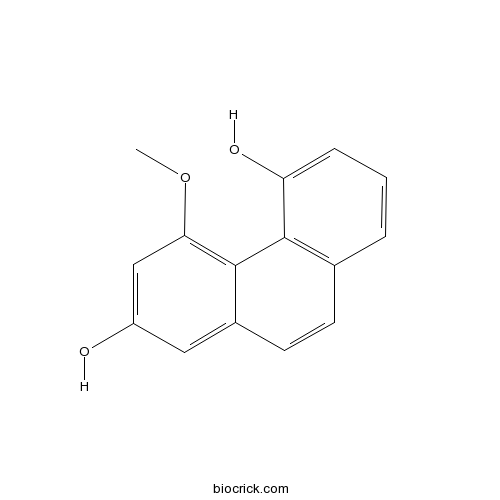MoscatinCAS# 108335-06-4 |

Quality Control & MSDS
3D structure
Package In Stock
Number of papers citing our products

| Cas No. | 108335-06-4 | SDF | Download SDF |
| PubChem ID | 194774 | Appearance | Powder |
| Formula | C15H12O3 | M.Wt | 240.25 |
| Type of Compound | Phenols | Storage | Desiccate at -20°C |
| Solubility | Soluble in Chloroform,Dichloromethane,Ethyl Acetate,DMSO,Acetone,etc. | ||
| Chemical Name | 4-methoxyphenanthrene-2,5-diol | ||
| SMILES | COC1=C2C(=CC(=C1)O)C=CC3=C2C(=CC=C3)O | ||
| Standard InChIKey | LVOCAIKGDCMNNK-UHFFFAOYSA-N | ||
| Standard InChI | InChI=1S/C15H12O3/c1-18-13-8-11(16)7-10-6-5-9-3-2-4-12(17)14(9)15(10)13/h2-8,16-17H,1H3 | ||
| General tips | For obtaining a higher solubility , please warm the tube at 37 ℃ and shake it in the ultrasonic bath for a while.Stock solution can be stored below -20℃ for several months. We recommend that you prepare and use the solution on the same day. However, if the test schedule requires, the stock solutions can be prepared in advance, and the stock solution must be sealed and stored below -20℃. In general, the stock solution can be kept for several months. Before use, we recommend that you leave the vial at room temperature for at least an hour before opening it. |
||
| About Packaging | 1. The packaging of the product may be reversed during transportation, cause the high purity compounds to adhere to the neck or cap of the vial.Take the vail out of its packaging and shake gently until the compounds fall to the bottom of the vial. 2. For liquid products, please centrifuge at 500xg to gather the liquid to the bottom of the vial. 3. Try to avoid loss or contamination during the experiment. |
||
| Shipping Condition | Packaging according to customer requirements(5mg, 10mg, 20mg and more). Ship via FedEx, DHL, UPS, EMS or other couriers with RT, or blue ice upon request. | ||
| Description | 1. Moscatin exhibits antiplatelet aggregation activity. |

Moscatin Dilution Calculator

Moscatin Molarity Calculator
| 1 mg | 5 mg | 10 mg | 20 mg | 25 mg | |
| 1 mM | 4.1623 mL | 20.8117 mL | 41.6233 mL | 83.2466 mL | 104.0583 mL |
| 5 mM | 0.8325 mL | 4.1623 mL | 8.3247 mL | 16.6493 mL | 20.8117 mL |
| 10 mM | 0.4162 mL | 2.0812 mL | 4.1623 mL | 8.3247 mL | 10.4058 mL |
| 50 mM | 0.0832 mL | 0.4162 mL | 0.8325 mL | 1.6649 mL | 2.0812 mL |
| 100 mM | 0.0416 mL | 0.2081 mL | 0.4162 mL | 0.8325 mL | 1.0406 mL |
| * Note: If you are in the process of experiment, it's necessary to make the dilution ratios of the samples. The dilution data above is only for reference. Normally, it's can get a better solubility within lower of Concentrations. | |||||

Calcutta University

University of Minnesota

University of Maryland School of Medicine

University of Illinois at Chicago

The Ohio State University

University of Zurich

Harvard University

Colorado State University

Auburn University

Yale University

Worcester Polytechnic Institute

Washington State University

Stanford University

University of Leipzig

Universidade da Beira Interior

The Institute of Cancer Research

Heidelberg University

University of Amsterdam

University of Auckland

TsingHua University

The University of Michigan

Miami University

DRURY University

Jilin University

Fudan University

Wuhan University

Sun Yat-sen University

Universite de Paris

Deemed University

Auckland University

The University of Tokyo

Korea University
- Ophiopogonanone B
Catalog No.:BCN8669
CAS No.:1316759-83-7
- 4''-methyloxy-Genistin
Catalog No.:BCN8668
CAS No.:950910-16-4
- 4''-methyloxy-Daidzin
Catalog No.:BCN8667
CAS No.:1195968-02-5
- Lappaol F
Catalog No.:BCN8665
CAS No.:69394-17-8
- Parvisoflavanone
Catalog No.:BCN8664
CAS No.:49776-79-6
- Aromadendrene
Catalog No.:BCN8663
CAS No.:489-39-4
- Angelicide
Catalog No.:BCN8662
CAS No.:92935-94-9
- Glicoricone
Catalog No.:BCN8661
CAS No.:161099-37-2
- Bacopaside I
Catalog No.:BCN8660
CAS No.:382148-47-2
- Vinaginsenoside R4
Catalog No.:BCN8659
CAS No.:156009-80-2
- Nuezhenidic acid
Catalog No.:BCN8658
CAS No.:183238-67-7
- Kanzonol C
Catalog No.:BCN8657
CAS No.:151135-82-9
- Epimagnolin B
Catalog No.:BCN8671
CAS No.:1134188-26-3
- Resveratroloside
Catalog No.:BCN8672
CAS No.:38963-95-0
- Pomiferin
Catalog No.:BCN8673
CAS No.:572-03-2
- Aurantio-obtusin beta-D-glucoside
Catalog No.:BCN8674
CAS No.:129025-96-3
- 13-Methylberberine
Catalog No.:BCN8675
CAS No.:54260-72-9
- Lappaol C
Catalog No.:BCN8676
CAS No.:64855-00-1
- Magnaldehyde B
Catalog No.:BCN8677
CAS No.:92829-72-6
- Flemiphilippinin A
Catalog No.:BCN8678
CAS No.:140366-64-9
- Kudinoside D
Catalog No.:BCN8679
CAS No.:173792-61-5
- Perisesaccharide C
Catalog No.:BCN8680
CAS No.:1311473-28-5
- Cafestol
Catalog No.:BCN8681
CAS No.:469-83-0
- Huzhangoside B
Catalog No.:BCN8682
CAS No.:94795-70-7
Antiplatelet aggregation principles of Dendrobium loddigesii.[Pubmed:7798962]
J Nat Prod. 1994 Sep;57(9):1271-4.
The MeOH extract of the stem of Dendrobium loddigesii was found to inhibit the aggregation of rabbit platelets induced by arachidonic acid and collagen. Two active compounds, moscatilin [1] and Moscatin [2], were isolated. Moscatilin diacetate [3] also exhibited antiplatelet aggregation activity.
[Chemical Constituents of Euphorbia lunulata].[Pubmed:26495651]
Zhong Yao Cai. 2015 Mar;38(3):514-7.
OBJECTIVE: To investigate the chemical constituents in the ethanol extract from the whole plant of Euphorbia lunulata. METHODS: The whole plant of Euphorbia lunulata was extracted by 95% ethanol, then partitioned by system solvents with different polarity. The ethyl acetate and n-butyl alcohol extracts were separated on silica gel, Sephadex LH-20,and MCI columns. The isolated compounds were determined by detailed analysis of their spectral data. RESULTS: Twelve compounds were isolated and identified from the ethyl acetate and n-butyl alcohol extracts of Euphorbia lunulata and the structures were identified as 7beta-methoxy-stigmast-5-ene-3beta-ol (1), 7beta-methoxy-stigmast-5-ene-3beta,22beta-diol(2), asperglaucide(3), Moscatin (4), p-hydroxybenzoic acid (5),3-methoxy-4-hydroxy benzoic acid(6), erigeside C(7),5,7,4'-trihydroxy flavanone(8), kaempferol(9), quercetin(10), corosolic acid(11) and acacetin (12). CONCLUSION: All compounds except for 9 and 10 are reported from this plant for the first time.


